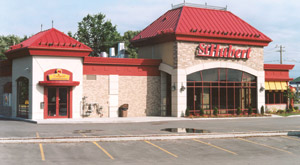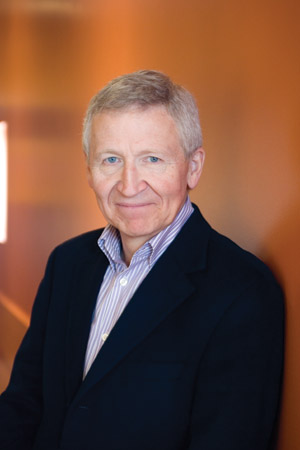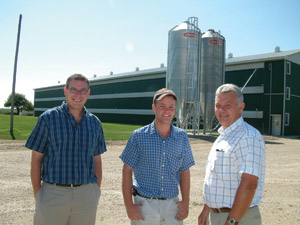
Demand for ABF Chicken Growing
By André Dumont
Features Profiles ResearchersAre Quebec broiler producers up to the challenge?
St-Hubert restaurants want to serve antibiotic-free (ABF) chicken. Are Quebec broiler producers up to the challenge?
 |
St-Hubert restaurants want to serve antibiotic-free (ABF) chicken. Are Quebec broiler producers up to the challenge?
When Jean-Pierre Léger speaks, Quebec broiler producers tend to take him seriously.
Earlier this year, the president of St-Hubert restaurants said publicly what industry insiders already knew: he wants to serve antibiotic-free chicken. This means more than 100,000 birds a week, for as many as 100 restaurants in Quebec, Ontario and New Brunswick.

|
| Jean-Pierre Léger, president of St-Hubert restaurants, knows that his clientele will start requesting antibiotic-free (ABF) chicken. |
Léger hasn’t set a specific deadline, but he warned that sooner or later, the St-Hubert clientele will request antibiotic-free chicken. If Quebec producers cannot supply the birds, he says he could turn to Ontario.
Antibiotic-free broiler production is still quite marginal in Quebec. It includes organic producers and participants in Shur-Gain’s (Nutreco) Countryside Chicken program.
In southwestern Ontario, Fisher Feeds is now producing 60,000 antibiotic-free broilers every week. The transition from traditional to antibiotic-free took almost five years but now the Listowel-based company sells all of its production as “raised without antibiotics.”
Detzler believes broiler producers could be able to supply a large restaurant chain like St-Hubert with antibiotic-free chicken. Quebec producers would have to pool their efforts and most importantly, overcome all the hurdles that lay ahead of any farmer trying to stop using antibiotics. Fisher Feeds is willing to share some of its experience, but not at the cost of revealing company secrets (see box).
Quebec ABF Production
Attempts at antibiotic-free production came to an end last year at the Ferme du Coq de Bruyère, near Victoriaville. The farm was supported by the Coop des Bois-Francs, a member of the Coop fédérée network. Liquid dejections, temperature control problems and several other factors affected animal growth. Resulting financial losses caused the farm to return to antibiotic use.
At the Ferme des Voltigeurs, next to Drummondville, some flocks are raised successfully without antibiotics, but are not marketed as such. Among problems that are still occurring is a non-specific enteritis, affecting animal weight and flock uniformity. “We’ve hit a wall, but we’re still trying,” production vice-president Bernard Martel says.
Technical problems shouldn’t be the greatest obstacle to large-scale antibiotic-free production, says Jean-Pierre Vaillancourt, a professor at University of Montreal’s veterinary medicine faculty. “The problem is not that we need more research to be able to do it. It’s a matter of finding a (production and marketing) structure that will be advantageous for everyone.”
Vaillancourt believes it is absolutely possible to produce in Quebec the volume of antibiotic-free chicken St-Hubert restaurants are looking for. But one huge problem will have to be addressed right from the start: for each bird that matches exactly St-Hubert’s weight specifications, processors will have to find a buyer for five to six other birds for which they will have already paid the producer a premium for not using antibiotics.
To supply such an important client as St-Hubert (some six million chickens per year), all of Quebec’s poultry sector will have to come together, says Martin Dufresne, the president of Les Éleveurs de volailles du Québec (Quebec broiler and turkey producers). A committee of producers, hatcheries, feed mill operators and processors will soon be set up, he told Canadian Poultry magazine.
“If we are to remove from the feed all products that classify as antibiotics – even ionophores, which some consider to be like antibiotics – it will be a big challenge,” Dufresne said.
Not all broiler producers are ready to improve their farm management to the point of no longer relying on antibiotics, Vaillancourt says. “We are asking them to produce without a safety net.”
However, according to Vaillancourt, many of them are up to the challenge and are already trying to minimize the use of antibiotics.
Production cost increases will vary significantly between farmers, Vaillancourt warns. Those with lower than average bird density will enjoy a smoother transition. Others will be faced with additional costs that could translate into 20 cents more per kilogram. This will definitely impact prices on St-Hubert’s menu.
But will this chicken really be better for human health? Many have doubts. Current regulation prevents the use of antibiotic drugs in the days before a bird reaches maturity. What’s left of antibiotics in the meat is more than a hundred times lower than accepted safety levels, Vaillancourt says.
However, Vaillancourt admits that a link does exist between antibiotic drug use in animals and resistance to antibiotics in human beings. But many believe that exaggerated use of antibiotics in human medicine is by far the greatest cause of human resistance.
If consumers request chicken raised without antibiotics and are willing to pay for it, then producers will respond, Dufresne says. But according to him, nothing really proves that this will be better for consumers’ and animals’ health.
“It’s like grain-fed chicken. What proves that it’s better or not? Chickens are omnivorous animals. When they are not fed animal protein, we can see that they don’t feel as well,” Dufresne says.
There is no need to produce antibiotic-free chicken to save humanity, Vaillancourt adds. “It’s more a matter of keeping up to date and improving. If we are able to, then why shouldn’t we do it?”

|
| Fisher Feeds sells all of its broilers as antibiotic-free. From left to right: Research and development manager Derek Detzler, farm manager Eric Martin and CEO Dr. Rae Fischer. |
| In southwestern Ontario, Fisher Feeds is now producing antibiotic-free broilers on all of its 14 farms. After five years, the trial and error period is now over. Over the last 12 months, its antibiotic-free production has jumped from 13,000 to 60,000 birds per week.
Fisher Feeds’ first move was to remove anti-coccidiosis drugs from the feed. Instead, the company used Intervet Schering-Plough’s Coccivac B vaccine for three rotations, but once winter hit, disease broke, and birds were give the original feed again. The following year, the vaccine was implemented on a permanent basis. With proper ventilation and temperature control, the first winter went by with no major glitch. According to Detzler, performance was equal to or better than on a drug. The second step involved replacing antibiotics used to control necrotic enteritis with natural products. “There are no magic bullets,” Detzler says. “But there are some products that have value. You just have to find the right combination.” Fisher Feeds also opted for better nutrition. Chicks are fed with a red pre-starter, a feed that maximizes early uptake in the first five days. “Studies are clear that the more a bird eats post hatch, the better it performs and the stronger its gut health and immune system get,” Detzler says. Management practices were also fine-tuned. In an attempt to anticipate disease outbreaks, more birds are weighted and more rectal temperatures are measured. Approximately 20 per cent of broilers still break out with necrotic enteritis, but Fisher Feeds found a way to treat them without antibiotic medication. “At present, we are selling 100 per cent of our birds antibiotic-free,” Detzler says. “We are proud of what we do and we believe this is the future of chicken |
Print this page